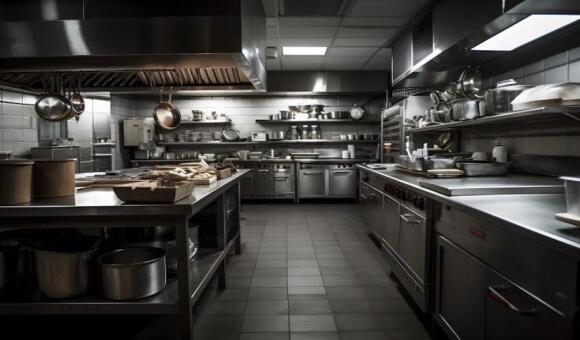Restaurant Equipment Checklist for New Food Businesses
Starting a new food business is an exciting venture filled with opportunities and challenges. One of the most critical steps in setting up a successful restaurant, café, or catering business is ensuring you have the right equipment. From cooking essentials to refrigeration and storage, the equipment you choose will directly influence your efficiency, food quality, and customer satisfaction. A well-prepared restaurant equipment checklist helps you avoid unnecessary delays, overspending, or overlooking key items.
This guide provides a comprehensive checklist of restaurant equipment for new food businesses, while also emphasizing the importance of kitchen equipment maintenance and the role of appliances like the under counter fridge in daily operations.
Why an Equipment Checklist Matters
For new food businesses, an equipment checklist serves as a roadmap. It prevents overspending on unnecessary items and ensures that the essentials are prioritized. Without a clear plan, restaurants often struggle with inefficiencies, frequent breakdowns, and high maintenance costs. An organized list also ensures your kitchen complies with safety and hygiene regulations.
Additionally, investing in quality equipment reduces the need for constant replacements, saving money in the long run. However, purchasing the right items is only half the battle—ongoing kitchen equipment maintenance is equally vital for extending the lifespan of your investment.
Essential Cooking Equipment
At the heart of any food business lies its cooking equipment. Depending on your cuisine, some items may vary, but the following are considered standard essentials:
1. Ovens
Ovens are indispensable for baking, roasting, and reheating. Convection ovens are common in many restaurants due to their even heat distribution, while specialty ovens (like pizza or combi ovens) may be required for specific menus.
2. Ranges and Stovetops
Gas or electric ranges with multiple burners are essential for sautéing, boiling, frying, and searing. Many restaurants also add griddles and charbroilers for versatility.
3. Fryers
Deep fryers are essential for fast-food concepts, cafés, and full-service restaurants alike. They are commonly used for fries, chicken, seafood, and other crispy dishes.
4. Microwaves
Although not a primary cooking tool, microwaves are useful for quick reheating and saving time during peak hours.
5. Specialty Equipment
Depending on your concept, you may need additional equipment like pasta cookers, steamers, or woks.
Refrigeration and Storage Equipment
Refrigeration plays a crucial role in food safety and inventory management. Ensuring the right balance of large storage and flexible options is key.
1. Walk-in Coolers and Freezers
These are ideal for bulk storage of perishable items. They provide ample space and make inventory management easier.
2. Reach-in Refrigerators
These standard upright refrigerators are essential for keeping daily-use ingredients fresh and accessible.
3. Under Counter Fridge
Compact and practical, the under counter fridge is an excellent choice for kitchens with limited space. It allows chefs to store frequently used items within arm’s reach, ensuring speed and convenience during service. This fridge type is especially helpful in bar areas, sandwich stations, and prep counters.
4. Freezers
Chest freezers or upright models help store frozen products for long-term use.
5. Dry Storage Solutions
Shelving units and racks keep non-perishable ingredients and supplies organized while maintaining hygiene standards.
Food Preparation Equipment
Preparation is often the most time-consuming part of cooking. With the right tools, efficiency and consistency improve significantly.
1. Mixers
Commercial mixers, whether countertop or floor-standing, are essential for bakeries, pizzerias, and other establishments requiring dough or batter preparation.
2. Food Processors
From slicing vegetables to making sauces, food processors save significant time and labor in a busy kitchen.
3. Slicers
Meat and cheese slicers improve efficiency and consistency in portion control, which is critical for both food cost management and quality.
4. Blenders and Juicers
Blenders are essential for smoothies, soups, and sauces, while juicers are vital for cafés or juice bars.
5. Cutting Tools and Boards
Knives, peelers, graters, and cutting boards are fundamental for precision and hygiene.
Beverage Equipment
If your restaurant serves beverages, investing in the right tools will enhance customer experience.
Coffee machines and grinders for cafés or breakfast spots
Beverage dispensers for juices, iced tea, or soft drinks
Kettles and hot water dispensers for tea service
Ice machines to ensure a steady supply of ice for drinks and food presentation
Dishwashing and Cleaning Equipment
Maintaining hygiene is non-negotiable in the food industry. Investing in cleaning equipment helps meet health codes and build customer trust.
1. Commercial Dishwashers
Available in under-counter, conveyor, or door-type models, these save time and ensure proper sanitation.
2. Sinks
Three-compartment sinks are often required by regulations for washing, rinsing, and sanitizing. Prep sinks and bar sinks may also be needed.
3. Cleaning Supplies
Stock detergents, sanitizers, scrubbers, and mops to ensure every corner of the kitchen stays clean.
Serving and Display Equipment
Presentation matters just as much as taste. Serving equipment should be functional, durable, and aesthetically pleasing.
Serving trays, plates, bowls, and glassware
Cutlery, napkins, and condiment dispensers
Buffet or display cases for self-service establishments
Heat lamps and food warmers to keep dishes at serving temperature
Safety and Compliance Equipment
A safe kitchen protects employees and customers alike. Beyond meeting legal requirements, prioritizing safety builds trust and prevents costly incidents.
Fire extinguishers and fire suppression systems
First aid kits
Non-slip mats for kitchen floors
Protective clothing like gloves, aprons, and hairnets
Proper ventilation systems to manage smoke and odors
Furniture and Front-of-House Essentials
While the back-of-house is the engine of your restaurant, the front-of-house determines customer comfort and satisfaction.
Dining tables and chairs
Host or cashier stands
POS (Point-of-Sale) systems for order and payment processing
Waiting area seating if applicable
The Importance of Kitchen Equipment Maintenance
Purchasing high-quality equipment is only the beginning. Without proper kitchen equipment maintenance, even the best machines will wear out quickly. Regular maintenance reduces downtime, prevents costly repairs, and extends the life of appliances.
Key Maintenance Tips:
Regular Cleaning: Keep ovens, fryers, and grills free of grease buildup.
Scheduled Servicing: Hire professionals for periodic servicing of refrigeration units, dishwashers, and ventilation systems.
Check Refrigeration: Monitor the temperature of walk-in coolers and the under counter fridge to ensure consistent food safety.
Inspect Electrical and Gas Lines: Prevent leaks, short circuits, or hazards by inspecting connections regularly.
Train Staff: Employees should know how to properly use and clean equipment to prevent misuse.
By treating maintenance as an ongoing responsibility rather than an afterthought, new food businesses can save significantly on repair costs and avoid interruptions during service.
Budgeting and Planning for Equipment
While it may be tempting to buy every piece of equipment upfront, a smarter approach involves prioritizing essentials. Create a phased plan:
Start with Core Items: Cooking ranges, refrigeration, prep tools, and dishwashing equipment.
Add Complementary Equipment: Mixers, slicers, specialty ovens, or beverage equipment based on menu demands.
Scale Gradually: As business grows, invest in advanced equipment like combi-ovens, high-capacity mixers, or additional freezers.
Always balance quality with budget—buying cheap equipment may lead to higher long-term costs due to breakdowns and replacements.
Final Thoughts
Setting up a new food business is a complex process, but having a well-thought-out restaurant equipment checklist simplifies the journey. From ovens and ranges to refrigeration solutions like the under counter fridge, each piece plays a vital role in delivering consistent quality and maintaining operational efficiency.
Equally important is a commitment to kitchen equipment maintenance, which ensures your investment lasts for years and supports uninterrupted service. By combining thoughtful planning, smart purchases, and proactive maintenance, new restaurant owners can build a strong foundation for long-term success.










 UnlockWare Group
UnlockWare Group
Comments (0)